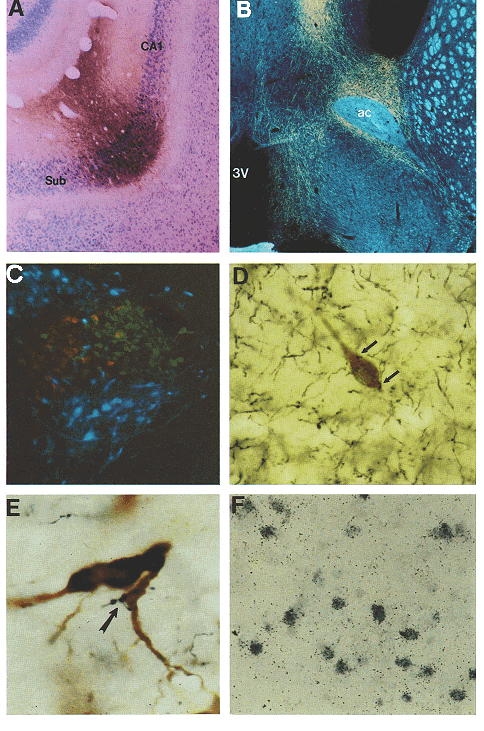
| Figure 9. |
 |
| An injection site of the anterograde neuronal tracer PHA-L within the ventral hippocampus. The tracer was detected immunocytochemically, resulting in a brown precipitate in neurons that have incorporated PHA-L. The section has been Nissl-counterstained. B: Dark-field photomicrograph illustrating the distribution of PHA-L-labeled fibers (gold) within the rat forebrain from the injection in A. C: Dual immunofluorescence combined with retrograde tracing. Triple exposure reveals distribution of neurons within the hypothalamic paraventricular nucleus which contain vasopressin (fluorescein-immunolabeled, green) or CRH (rhodamine-immunolabeled, red), as well as those retrogradely labeled from the spinal cord using the tracer true blue. (Figure kindly provided by Drs. Larry W. Swanson and Paul E. Sawchenko. From ref. 36, with permission.) D: Retrograde neuronal tracing in combination with anterograde tracing. A neuron located within the bed nucleus of the stria terminalis is retrogradely labeled with the tracer Fluoro-gold, which was injected into the hypothalamic paraventricular nucleus and detected immunocytochemically. This neuron is approached by axon terminals (arrows) labeled with PHA-L, following an injection of this anterograde tracer in the ventral subiculum. E: Anterograde neuronal tract-tracing combined with ChAT immunocytochemistry. PHA-L-labeled terminal boutons are seen in apposition to a cholinergic neuron located in the basal forebrain following delivery of the tracer to the lateral hypothalamus. F: Dual in situ hybridization. Striatal neurons expressing enkephalin mRNA (purple) have been detected with a nonradioactive in situ hybridization technique using a digoxigenin-labeled cRNA probe. Grains located over these cells represent labeling from a radioactive cRNA probe specific for D2 dopamine receptor mRNA. (Courtesy of Dr. Eileen J. Curran.) |
published 2000